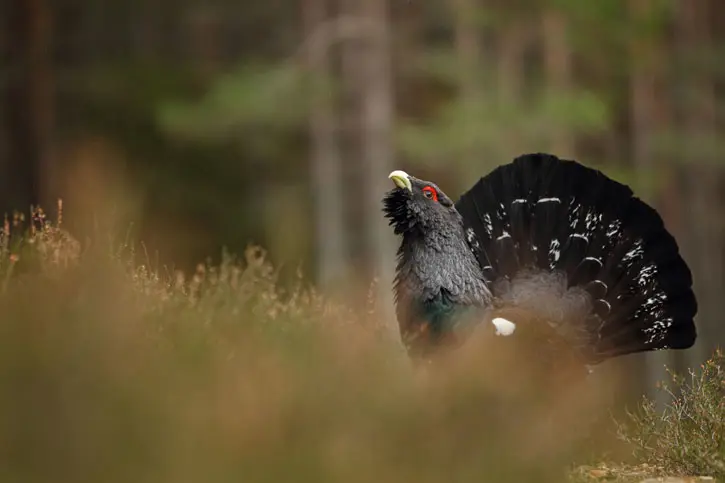Capercaillie conservation
Capercaillie conservation
The magnificent capercaillie is on the verge of extinction in Scotland. We’ve taken action to help slow their decline but numbers remain dangerously low. Today, it is thought there are fewer than 60 male capercaillie in Scotland's national forests.
So what’s the problem? The males in particular are aggressive turkey-sized birds that look more than capable of taking care of themselves. In spring, they strut and posture, and can get into ferocious fights with other males to maintain their status.
The birds facing the biggest fight, however, are the females and their chicks.

Luke Massey/2020VISION
Threats to capercaillie survival
- One of the biggest problems is the poor Scottish weather. Prolonged cool weather in spring prevents females from getting into breeding condition in the first place, while wet summers chill chicks that are already struggling to find enough food to survive.
- Nesting females and vulnerable chicks are also under threat from forest predators. And even before hatching, many eggs are stolen by crows and other scavengers.
- The problems don’t stop when they’re big enough to fly. Many capercaillie of all ages – males too – crash into deer fences and are killed.
- Capercaillie can also be disturbed by dog-walkers and enthusiastic wildlife watchers. Make sure you follow the RSPB code of conduct for watching endangered species.
Conservation efforts
Despite what some people might think, forests managed for timber production provide an excellent habitat for capercaillie. However, future success relies on a lot of planning by foresters to ensure that birds are not disturbed during their breeding season.
In forests where capercaillie are found, we have removed as much of the deer fencing as possible – or made it more visible to flying birds.
What do capercaillie eat?
Adult birds eat conifer shoots and buds, but really love blaeberry. Young chicks feed on insects they find in the ground vegetation.
By lightly thinning tree cover and not clear-felling large areas, we’ve found that both blaeberry and insects flourish. Good news for hungry capercaillie.
The future
The threatened capercaillie isn’t out of the woods yet. However, there is evidence that numbers are increasing in two important sites in Strathspey.
There are some things we can’t change – like the weather. But thanks to the careful management of our forests, the future might be brighter for one of our most iconic species.